英语主动语态和被动语态ppt课件
合集下载
英语B级考试语法PPT课件
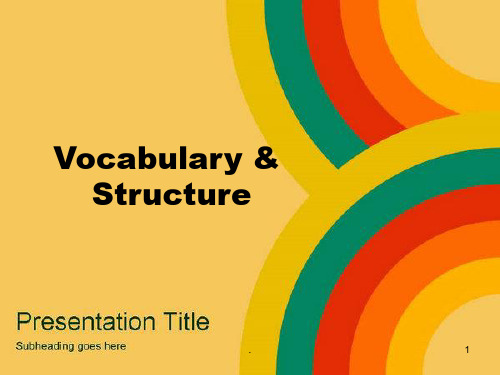
A. sent B. be sent C. was sent D. being sent
B. 2.As far as I’m concerned, I don’t like ______ in
C. that way.
D. A.to be treated B.to treat C. treated D.treating
I. had been paid B. has been paid C. will be paid
.
5
J. D. will have paid.
1.The final decision (make)_____ by the team leader early next week.
2.We can arrange for your car to (repair)______ within a reasonable period of time.
假如我是你的话,我就不会要那钱。
• 与过去事实相反 We would have dropped by if we had had time.
假若我们有时间的话,我们就会顺道拜访。
• 与将来事实可能相反 If you dropped the glass, it would break. 假如你把玻璃杯掉在地上,它会打碎的。
2. I want (point out) ______ that a decision about the matter must be made at once.
3. If your credit is good, you will be allowed (use)______ the credit card.
• 用在宾语从句,一种是用作动词wish的宾语从句, 另一种是谓语用should+动词原形或只用动词原 形的that从句
主动语态和被动语态课件

句子。
转换过程中的注意事项
注意时态一致性
在进行主动和被动转换时 ,需要注意保持时态的一 致性,即现在时、过去时 、将来时等。
注意语态一致性
在进行主动和被动转换时 ,还需要注意保持语态的 一致性,即进行时、完成 时等。
注意语义完整性
在进行主动和被动转换时 ,需要确保句子的语义完 整性,避免出现歧义或误 解。
对比分析
主动语态强调动作的执行者,即“谁做了什 么”;而被动语态强调动作本身,即“什么 被做了”。
在某些情况下,使用主动语态更自然、更常 见;而在其他情况下,使用被动语态可能更 合适,特别是当我们想要强调动作本身而非 执行者时。
在科技、商业、法律和其他正式文体中,被 动语态的使用更为常见,因为它可以提供更 客观、中立的表达方式。
02
主动语态强调动作的执行者,通 常用于描述某个人的行为、动作 或状态,例如“他读书”、“他 们唱歌”等。
被动语态的定义
被动语态是指句子中的主语是动作的 接受者,谓语动词使用被动形式的语 法结构。
被动语态强调动作的结果或状态,通 常用于描述某个事物的状态或行为, 例如“书被读完了”、“歌曲被唱完 了”等。
05
主动语态和被动语态的练习与巩固
单项选择练习
总结词
通过选择题的形式,考察学生对主动 语态和被动语态的理解和应用。
详细描述
设计一系列关于主动语态和被动语态 的单项选择题,题目应涵盖语法规则 、时态、语态等多个方面,要求学生 根据语境选择正确的语态。
改错练习
总结词
通过改正句子中的错误,帮助学生识别并纠正主动语态和被动语态的使用错误 。
被动语态常用于描述动作的承受 者,强调动作对主语的直接作用
。
转换过程中的注意事项
注意时态一致性
在进行主动和被动转换时 ,需要注意保持时态的一 致性,即现在时、过去时 、将来时等。
注意语态一致性
在进行主动和被动转换时 ,还需要注意保持语态的 一致性,即进行时、完成 时等。
注意语义完整性
在进行主动和被动转换时 ,需要确保句子的语义完 整性,避免出现歧义或误 解。
对比分析
主动语态强调动作的执行者,即“谁做了什 么”;而被动语态强调动作本身,即“什么 被做了”。
在某些情况下,使用主动语态更自然、更常 见;而在其他情况下,使用被动语态可能更 合适,特别是当我们想要强调动作本身而非 执行者时。
在科技、商业、法律和其他正式文体中,被 动语态的使用更为常见,因为它可以提供更 客观、中立的表达方式。
02
主动语态强调动作的执行者,通 常用于描述某个人的行为、动作 或状态,例如“他读书”、“他 们唱歌”等。
被动语态的定义
被动语态是指句子中的主语是动作的 接受者,谓语动词使用被动形式的语 法结构。
被动语态强调动作的结果或状态,通 常用于描述某个事物的状态或行为, 例如“书被读完了”、“歌曲被唱完 了”等。
05
主动语态和被动语态的练习与巩固
单项选择练习
总结词
通过选择题的形式,考察学生对主动 语态和被动语态的理解和应用。
详细描述
设计一系列关于主动语态和被动语态 的单项选择题,题目应涵盖语法规则 、时态、语态等多个方面,要求学生 根据语境选择正确的语态。
改错练习
总结词
通过改正句子中的错误,帮助学生识别并纠正主动语态和被动语态的使用错误 。
被动语态常用于描述动作的承受 者,强调动作对主语的直接作用
。
主动语态和被动语态(课堂PPT)

1. People play football all over the world.
Football is played all over the world by people .
2. Mr. Green teaches us this term.
We are taught (by Mr. Green) this term.
I bPealiessvieveI cVaonicfely
被动语态
This song is enjoyed by people all
over the world.
1
EEnnglgislihsh iiss ssppookkeenn bpyetohpele most people in the world.
2. The students in this school study German.
German __is_____ __s_tu_d_i_e_d_ by the
students in this school.
11
3.I found the ticket on the floor. The ticket __w_a_s__ f_o_u_n_d__ on the floor. 4.I told her to return the book in time. She __w__a_s_ __t_o_ld___ to return the book in time.
2
TThheeGGrreeat wWaalll wasbubilutilt by Chinese people.
3
The ttrreeeess wereplpalnatnedted by students.
4
Football is played all over the world by people .
2. Mr. Green teaches us this term.
We are taught (by Mr. Green) this term.
I bPealiessvieveI cVaonicfely
被动语态
This song is enjoyed by people all
over the world.
1
EEnnglgislihsh iiss ssppookkeenn bpyetohpele most people in the world.
2. The students in this school study German.
German __is_____ __s_tu_d_i_e_d_ by the
students in this school.
11
3.I found the ticket on the floor. The ticket __w_a_s__ f_o_u_n_d__ on the floor. 4.I told her to return the book in time. She __w__a_s_ __t_o_ld___ to return the book in time.
2
TThheeGGrreeat wWaalll wasbubilutilt by Chinese people.
3
The ttrreeeess wereplpalnatnedted by students.
4
英语语法讲解之主动和被动语态PPT课件
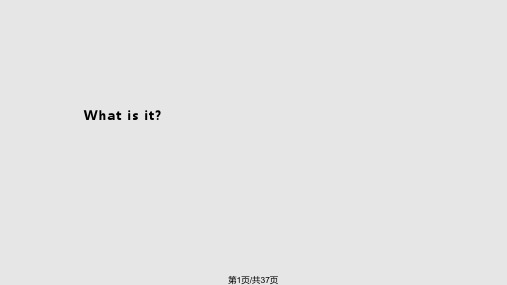
lab without a teacher. We are not allowed to enter the chemistry lab
without a teacher.
第8页/共37页
2. 一般过去时: They agreed on the building of a new car
factory last month. The building of a new car factory was
tickets had already been sold out. The whole country was very sad at the
news of his death; People had considered him to be a great leader.
He had been considered to be a great leader.
第5页/共37页
• (2)英语中被动语态由“助动词be +动词的过去分词”构成。助动词be 有时态、人称和数的变化。被动语态后的by短语有时可省去。具体结构 见下表:
现在时态 一般现在时 现在进行时
一般将来时
现在完成 时
am
am
will + be+p.p.
have(has)
谓语动词 is +p.p. is
• 相似动词see, watch, hear, notice, listen to, look at, make, feel,have,let
第22页/共37页
• ③“动词+…+介词”改为被动时,介词一般在原位不动。如:The girl takes good care of her little brother.→ The girl’s little brother is taken good care of by her.
without a teacher.
第8页/共37页
2. 一般过去时: They agreed on the building of a new car
factory last month. The building of a new car factory was
tickets had already been sold out. The whole country was very sad at the
news of his death; People had considered him to be a great leader.
He had been considered to be a great leader.
第5页/共37页
• (2)英语中被动语态由“助动词be +动词的过去分词”构成。助动词be 有时态、人称和数的变化。被动语态后的by短语有时可省去。具体结构 见下表:
现在时态 一般现在时 现在进行时
一般将来时
现在完成 时
am
am
will + be+p.p.
have(has)
谓语动词 is +p.p. is
• 相似动词see, watch, hear, notice, listen to, look at, make, feel,have,let
第22页/共37页
• ③“动词+…+介词”改为被动时,介词一般在原位不动。如:The girl takes good care of her little brother.→ The girl’s little brother is taken good care of by her.
九年级英语主动语态和被动语态课件ppt
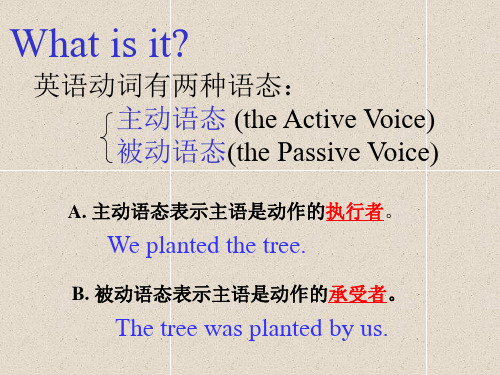
A. 主动语态表示主语是动作的执行者。
We planted the tree.
B. 被动语态表示主语是动作的承受者。
The tree was planted by us.
经营者提供商品或者服务有欺诈行为 的,应 当按照 消费者 的要求 增加赔 偿其受 到的损 失,增 加赔偿 的金额 为消费 者购买 商品的 价款或 接受服 务的费 用
A birthday party
is going to held by Tom
.
情态动词的被动语态: 经营者提供商品或者服务有欺诈行为的,应当按照消费者的要求增加赔偿其受到的损失,增加赔偿的金额为消费者购买商品的价款或接受服务的费用
must/have to/can等 + be + 过去分词
8. You must throw the broken pottery
典型题例
例1 将下列句子改为被动语态。 We clean our classroom every day.
Our classroom is cleaned (by us) every day.
在改写中应注意:
1.把原来的宾语提到前面作被动语态的主语; 2.把动词变成“be + 过去分词”; 3.主动语态中的主语变为介词by的宾语。
We speak
主语
谓语
English.
宾语
主动语态
English is spoken by us.
主语
谓语
宾语
被动语态
当主语是动作的执行者时,动词用主动语态 经营者提供商品或者服务有欺诈行为的,应当按照消费者的要求增加赔偿其受到的损失,增加赔偿的金额为消费者购买商品的价款或接受服务的费用 (Active Voice);如果主语是动作的承受者, 动词便用被动语态(Passive Voice)。
We planted the tree.
B. 被动语态表示主语是动作的承受者。
The tree was planted by us.
经营者提供商品或者服务有欺诈行为 的,应 当按照 消费者 的要求 增加赔 偿其受 到的损 失,增 加赔偿 的金额 为消费 者购买 商品的 价款或 接受服 务的费 用
A birthday party
is going to held by Tom
.
情态动词的被动语态: 经营者提供商品或者服务有欺诈行为的,应当按照消费者的要求增加赔偿其受到的损失,增加赔偿的金额为消费者购买商品的价款或接受服务的费用
must/have to/can等 + be + 过去分词
8. You must throw the broken pottery
典型题例
例1 将下列句子改为被动语态。 We clean our classroom every day.
Our classroom is cleaned (by us) every day.
在改写中应注意:
1.把原来的宾语提到前面作被动语态的主语; 2.把动词变成“be + 过去分词”; 3.主动语态中的主语变为介词by的宾语。
We speak
主语
谓语
English.
宾语
主动语态
English is spoken by us.
主语
谓语
宾语
被动语态
当主语是动作的执行者时,动词用主动语态 经营者提供商品或者服务有欺诈行为的,应当按照消费者的要求增加赔偿其受到的损失,增加赔偿的金额为消费者购买商品的价款或接受服务的费用 (Active Voice);如果主语是动作的承受者, 动词便用被动语态(Passive Voice)。
被动语态ppt课件

4. Then one day, without a writing degree or contacts in the writing world — just a lot of hard work — I was offered (offer) a publishing deal(出版协议)for my first book!
谢谢观赏!
识别判断
5. I knew what he meant. I was allowed (allow) to pick a dollar’ s worth of candy every time when I came to the store with Grandma.
6. I was encouraged (encourage) greatly by her words. Years later, they still remain inside of me.
➢ 过去分词作后置定语,表示被动含义。 e.g. The novel written by Mo Yan is really popular.
➢ 以下句型结构可以用主动形式表示被动含义: need doing sth. 需要被做某事 require doing sth. 需要被做某事 be worth doing sth. 值得被做某事
被动语态
01 含义理解 02 基本结构 03 重要考点 04 识别判断 05 特殊用法
01 含义理解
含义理解
➢ 语态分类:
(1) 主动语态:主语为动作的执行者 (2) 被动语态:主语为动作的承受者
含义理解
➢ 主动语态: I watered the flowers yesterday. 我昨天浇了花。 主语(动作的执行者)
谢谢观赏!
识别判断
5. I knew what he meant. I was allowed (allow) to pick a dollar’ s worth of candy every time when I came to the store with Grandma.
6. I was encouraged (encourage) greatly by her words. Years later, they still remain inside of me.
➢ 过去分词作后置定语,表示被动含义。 e.g. The novel written by Mo Yan is really popular.
➢ 以下句型结构可以用主动形式表示被动含义: need doing sth. 需要被做某事 require doing sth. 需要被做某事 be worth doing sth. 值得被做某事
被动语态
01 含义理解 02 基本结构 03 重要考点 04 识别判断 05 特殊用法
01 含义理解
含义理解
➢ 语态分类:
(1) 主动语态:主语为动作的执行者 (2) 被动语态:主语为动作的承受者
含义理解
➢ 主动语态: I watered the flowers yesterday. 我昨天浇了花。 主语(动作的执行者)
主动语态与被动语态ppt

注意:need后可接动名词表被动,又可接动词不定式的被动形式。但若有附加成分有用动词不定式的被动形式。比较: The desk needs repairing. The desk needs to be repaired.
4) 注意动名词的被动形式,(being done) Nobody likes being laughed of. 没人喜欢被嘲笑。
何时用被动语态
4)有些短语不用被动语态 do one’s best, make a face, make room(腾位子), make up one’s mind, belong to
不用被动语态的情况
1)不及物动词不用被动语态;注意:happen, break out ,take place The story was happened in 1934. ( × )
过去进行时态:was/were + being +过去分词
一般将来时态:will + be+过去分词
过去将来时态:would + be+过去分词
7、With the help of the Hope Project, more and more new schools _____ in the poor area. A. built B. have built C. have been built D. have been building 8、He came out and told us that the work __________. A. finished B. was finished C. had finished D. had been finished 9、The programmes _______ easily if you use a short wave radio. A. can pick up B. pick up C. picked up D. can be picked up
4) 注意动名词的被动形式,(being done) Nobody likes being laughed of. 没人喜欢被嘲笑。
何时用被动语态
4)有些短语不用被动语态 do one’s best, make a face, make room(腾位子), make up one’s mind, belong to
不用被动语态的情况
1)不及物动词不用被动语态;注意:happen, break out ,take place The story was happened in 1934. ( × )
过去进行时态:was/were + being +过去分词
一般将来时态:will + be+过去分词
过去将来时态:would + be+过去分词
7、With the help of the Hope Project, more and more new schools _____ in the poor area. A. built B. have built C. have been built D. have been building 8、He came out and told us that the work __________. A. finished B. was finished C. had finished D. had been finished 9、The programmes _______ easily if you use a short wave radio. A. can pick up B. pick up C. picked up D. can be picked up
英语主动语态和被动语态课件

Detailed description
The teacher provides sentences containing grammar errors for students to identify and correct, while explaining the reasons for the errors and the correct usage.
action
It is more direct and consensus, making it suitable for most writing and speaking
situations
The subject of the presence is typically the doorstep of the
Impersonality
The active voice is less personal, focusing on the action compared to the person performing it
Energy and Emphasis
The active voice brings energy and emphasis to the presence, drawing attention to the subject
Passive Voice • Practice of active and passive voice • Notes on active and passive voice
01
The definitions of active and passive
voice
The definition of active voice
It is often used when the focus of the presence is on the action rather than the doer
The teacher provides sentences containing grammar errors for students to identify and correct, while explaining the reasons for the errors and the correct usage.
action
It is more direct and consensus, making it suitable for most writing and speaking
situations
The subject of the presence is typically the doorstep of the
Impersonality
The active voice is less personal, focusing on the action compared to the person performing it
Energy and Emphasis
The active voice brings energy and emphasis to the presence, drawing attention to the subject
Passive Voice • Practice of active and passive voice • Notes on active and passive voice
01
The definitions of active and passive
voice
The definition of active voice
It is often used when the focus of the presence is on the action rather than the doer
高中英语被动语态课件(共16张PPT)

2. 由动词+ 介词或副词构成的短语动词,要把它们作为整体看,即 把它们看成一个及物动词,介词或副词不可拆开或漏掉。这类动词 有: (1)不及物动词+ 介词,如: agree to, ask for, laugh at, operated on, listen to, look after, think of, talk about 等。 The patient is being operated on. The problem is solved. It needn't be talked about. (2)及物动词+ 副词:如:bring about, carry out, find out, give up, hand in, make out, pass on, point out, put away, put off, think over, turn down, work out, turn out 等。 His request was turned down. The sports meet will be put off because of the bad weather.
被动: The price has been brought down.
7. 过去完成时: had + been + given
1) 主动:When I got to the theatre, I found they had already sold out the tickets.
被动:When I got to the theatre, I found the tickets had already been sold out.
动词的过去分词”构成。 1)主动:You must hand in your compositions after
九年级英语主动语态和被动语态课件
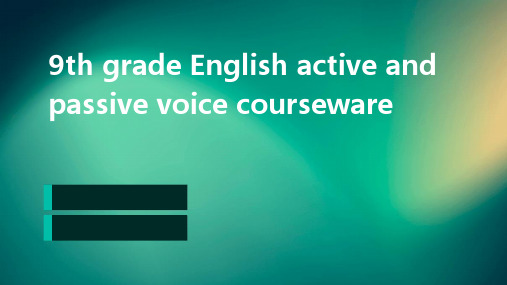
Emphasize the action receiver
01
The passive voice can be used to focus attention on the recipient of the action, rather than the person performing it
02
The Conversion of
04 Active Voice and Passive Voice
Convert active voice to passive voice
Identifying the executor of an action: In active voice sentences, the action is performed by a certain executor, and we need to find that executor.
Emphasize the initiator of the action
Use active voice to emphasize the person or thing responsible for the action described in a sentence
Active voice helps to bring focus on the initiator of the action, making it clear who or what is performing the task or action
9th grade English active and passive voice courseware
contents
目录
• The definitions of active and passive voice
主动语态和被动语态ppt课件

用所给动词的正确形式填空: 1). The bike w__as__f_ix_e_d___(fix) up by Xiao
Ming yesterday.
2). Sunglasses __ar_e__u_se_d___ (use) for
protecting people’s eyes.
3). A picture _i_s __p_ut____(put) up on the
D. happened
happen, take place 等不及物动词无被 动语态
完整版ppt课件
18
小结
一般现在时:am / is / are +done 一般过去时:was / were+ done
情态动词:can / must / +be done
Attention:
被动语态还原不定式 to
E.g: I saw him leave the house.
→He was seen to leave the house.
完整版ppt课件
15
试一试
He makes her horse work all day. Her horse is made to work all day. My father let me go out for a picnic. I was let to go out for a picnic.
系动词用主动表被动。
有些动词无被动语态。
完整版ppt课件
19
中考考什么
1. A neighbor helped to keep our dog. It _____D_____while we were on holiday. (2005)
初二英语一般现在时被动语态教学课件共18张PPT

several times so far. 3.What time _w_i_ll_ the meeting __b_e_g_in__(begin)? 4.It __co_s_t_s_ (cost) 100 Yuan. 5.Water the flower soon, or it _w_il_l _d_ie_(die).
see/hear/notice sb. do sth. sb. be seen/heard/noticed to do sth.
let/make/have sb. do sth. sb. be let/made/had to do sth.
• The boss makes the workers work all day. The workers are made to work all day.
3,主动语态中“动词+介词”或“动词&hey look after the girl well. The girl is looked after well by them.
He often laughs at the poor boy. The poor boy is often laughed at by him.
The river is polluted seriously
Some trees are cut down.
A sports meeting is held in our school every year.
The whale is killed for its fin.
1,感官动词、使役动词等在主动语态中后接零动词不定式 变成被动语态时要加上“to”
6,每天早晨都能听得鸟儿的叫声。 Some birds are heard to sing every morning. 7,每天有很多病人要动手术。 Many patients are operated on every day. 8,这款新手机很好销售。 The new kind of mobile phones sells well.
see/hear/notice sb. do sth. sb. be seen/heard/noticed to do sth.
let/make/have sb. do sth. sb. be let/made/had to do sth.
• The boss makes the workers work all day. The workers are made to work all day.
3,主动语态中“动词+介词”或“动词&hey look after the girl well. The girl is looked after well by them.
He often laughs at the poor boy. The poor boy is often laughed at by him.
The river is polluted seriously
Some trees are cut down.
A sports meeting is held in our school every year.
The whale is killed for its fin.
1,感官动词、使役动词等在主动语态中后接零动词不定式 变成被动语态时要加上“to”
6,每天早晨都能听得鸟儿的叫声。 Some birds are heard to sing every morning. 7,每天有很多病人要动手术。 Many patients are operated on every day. 8,这款新手机很好销售。 The new kind of mobile phones sells well.
初中英语语法大全——被动语态(共16张PPT)

eg: She sings the English song. eg: The English song is sung by her.
2. 各种时态及情态动词的被动语态
3. 被动语态的各种句式
eg: A road has been built by the government. 一条道路已经被政府修建了。 eg: I am not invited to go to the party by my friend. 我没有被朋友邀请去参 加聚会。 eg: Are trees being planted over there by them? 那边的树正在被他们种植 吗? eg: When was the basketball team set up? 这支篮球队是什么时候成立的?
Bruce writes a letter every week. → A letter is written by Bruce every week.
2. 动语态转化为被动语态的各种情况
(1) 主语+谓语+宾语... (主语+be done+by) 主动语态:No one has ever beaten Sonya at tennis. 被动语态:Sonya has never been beaten (by...) at tennis. (2)A. 主语+谓语+间接宾语+直接宾语 ( 主语+be done+直接 宾语(+by...) 主动语态:They give the children many good books. 被动语态:The children were given many good books. B.主语+谓语+间接宾语+直接宾语 (主语+ be done to/ for+ 间接宾语(by...)、 主动语态:They give the children many good books. 被动语态:Many good books were given to the children by them.
2. 各种时态及情态动词的被动语态
3. 被动语态的各种句式
eg: A road has been built by the government. 一条道路已经被政府修建了。 eg: I am not invited to go to the party by my friend. 我没有被朋友邀请去参 加聚会。 eg: Are trees being planted over there by them? 那边的树正在被他们种植 吗? eg: When was the basketball team set up? 这支篮球队是什么时候成立的?
Bruce writes a letter every week. → A letter is written by Bruce every week.
2. 动语态转化为被动语态的各种情况
(1) 主语+谓语+宾语... (主语+be done+by) 主动语态:No one has ever beaten Sonya at tennis. 被动语态:Sonya has never been beaten (by...) at tennis. (2)A. 主语+谓语+间接宾语+直接宾语 ( 主语+be done+直接 宾语(+by...) 主动语态:They give the children many good books. 被动语态:The children were given many good books. B.主语+谓语+间接宾语+直接宾语 (主语+ be done to/ for+ 间接宾语(by...)、 主动语态:They give the children many good books. 被动语态:Many good books were given to the children by them.
初中英语主动语态和被动语态(共21张PPT)
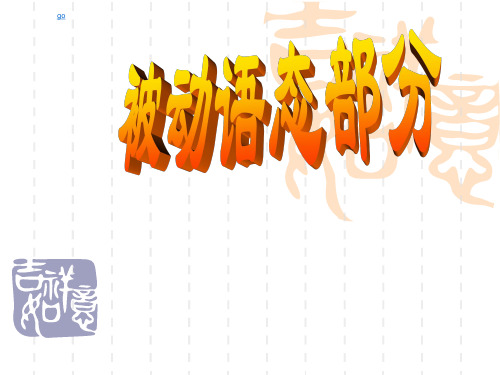
sb be watched to do
观
sth
动 hear sb do sth 词
sb be heard to do sth
notice sb do sth sb be noticed to do sth
②含有短语的被动语态结构。
一般来说,只有及物动词才有被动语态,因为只有及物动词才有承 受者。
但许多不及物动词加上副词或介词构成动词短语也相当于及物动词的用 法,可以
③We have learned 3000 English words so far.(主动) → 3000 English words have been learned by us so far.
Fill in the blanks with the Passive Voice.
1、Tea i_s_g_r_o_w__n (grow) in Fujian. 2、Chinese _i_s_s_p_o__k_e_n_ (speak) in China. 3、The bed ___is__u_s_e_d__ (use) for sleeping. 4、Our classroom _i_s_c_le_a_n__e_d (clean) every day. 5、The cars _a_r_e__m_a_d_e__ (make) in Beijing.
什么时候要用被动语态呢? 在下列三种情况之一要用被动语态: ①不知道动作的执行者是谁,用被动语态。 ②没有必要指出谁是动作的执行者,用被动
语态。 ③需要强调动作的承受者时,用被动语态
主动句中谓语动词的发出者由by引出,作为by的宾语,也可以省略。
请看以下主动语态和被动语态结构的转换:
主动语态:主语+谓语+宾语
被动语态PPT课件

11.In this factory women do most of the work.
Most of the work __i_s____ __d_o_n_e___ by women in this factory.
12.He can mend the bike in two days. The bike __c_a_n__ ___b_e__ _m_e_n_d_e_d_ in two days.
The tall building was builtபைடு நூலகம்by them last year.
• He took good care of his little brother yesterday.
His little brother was taken good care of by him yesterday.
Shoes are made (by them) in that factory. 一般现在时: S(主语)+am/is /are +过去分词
• They play football on Sunday.
Football is played by them on Sunday.
• Lucy does the homework in the evening.
(The Passive Voice)
.主动语态与被动语态:
英语动词有两种语态,即主动语态(The
Active Voice)与被动语态(The Passive Voice)。
主动语态表示主语是动作的执行者;被动语态表示
主语是动作的承受者。
e.g. 1.They make trains in Zhuzhou .
English should be learned well by them.
Most of the work __i_s____ __d_o_n_e___ by women in this factory.
12.He can mend the bike in two days. The bike __c_a_n__ ___b_e__ _m_e_n_d_e_d_ in two days.
The tall building was builtபைடு நூலகம்by them last year.
• He took good care of his little brother yesterday.
His little brother was taken good care of by him yesterday.
Shoes are made (by them) in that factory. 一般现在时: S(主语)+am/is /are +过去分词
• They play football on Sunday.
Football is played by them on Sunday.
• Lucy does the homework in the evening.
(The Passive Voice)
.主动语态与被动语态:
英语动词有两种语态,即主动语态(The
Active Voice)与被动语态(The Passive Voice)。
主动语态表示主语是动作的执行者;被动语态表示
主语是动作的承受者。
e.g. 1.They make trains in Zhuzhou .
English should be learned well by them.
- 1、下载文档前请自行甄别文档内容的完整性,平台不提供额外的编辑、内容补充、找答案等附加服务。
- 2、"仅部分预览"的文档,不可在线预览部分如存在完整性等问题,可反馈申请退款(可完整预览的文档不适用该条件!)。
- 3、如文档侵犯您的权益,请联系客服反馈,我们会尽快为您处理(人工客服工作时间:9:00-18:30)。
The Structure is
助动词be+及物动词的过去分词
(be+P.P.)
He is regarded as a brilliant. 他Th一被is般认b现o为在o很k时w有:a才asm气wr/。iitste/nairne 1d9o6n9e. 这T一h本e般书b过r是o去k1时e9n:69bw年ika写esi成s/ wb的ee。rinegdroenpeaired now. 那H现过e辆在去t坏o进 进l了d行行u时时的s::自th行awema车csa/正/tisw在/eaa被rsree修bbeb理eienini。gnggwddaosonhneeed when w现e在c完al成le时d :himha. ve / has been done 他过Th告去e完诉p成e我n时们h:a打sh电abde话eb时neeu他ns正eddo在fno给er 猫se洗ve澡ra。l years.
一这般支将钢来笔时已:经s用ha了ll 几/ w年il。l be done ; be going to说当b这句e中家d含o工n有厂e情已态经动开词张时,。句H子e s结a构id为thceafnac/ tmouryst / hhaadvebteoe…nboepednoende . 他
The baby must be looked after well. The这w孩o子rk必w须ill被be好f好ini照sh顾ed。in three hours. 工作将于三小时后完成。
被动语态的结构:
被动语态由“助动词be+及物动词的过去分 词”构成,助动词be有人称、数的变化,其变 化规则与be作为连系动词时一样。 如: The desk is made of wood.
The desks are made of wood.
He is asked a question by the teacher.
The tree was planted by us.
We speak
主语
谓语
English.
宾语
主动语态
English is spoken by us.
主语
谓语
宾语
被动语态
当主语是动作的执行者时,动词用主动语态 (Active Voice);如果主语是动作的承受者, 动词便用被动语态(Passive Voice)。
(强调书被发现而不是强调由谁发现)
被动语态的用法:
1.强调动作的承受者;
如:Table tennis is played all over China. English is spoken by many people.
2.不需要指出动作的执行者或动作的执 行者难以说出或不必说出.
如:Another bridge has been built across the Changjiang River. The Party was founded on July 6,1924. A note was passed up to the speaker.
I was given a nice present by my friend yesterday.
典型题例
例1 将下列句子改为被动语态。 We clean our classroom every day.
Our classroom is cleaned (by us) every day.
在改写中应注意:
1.把原来的宾语提到前面作被动语态的主语; 2.把动词变成“be + 过去分词”; 3.主动语态中的主语变为介词by的宾语。
主变被解题步骤:
1. 找宾语 ----即动作的承受者
2. 判断宾语的单复数 ----即be动词的单复数. 3. 判断动词的时态 ----即be动词的时态. 4. 修改谓语的时态 ----即原句动词改为过去分词 5. 修改原句的主语 ----即by+ 主语.
They make shoes in that factory.
are Shoes
made by them.
were
Tom broke the window. The window was broken by Tom.
Tom broke the windows.
The windows were broken by Tom. He broke the windows. The windows were broken by him.
What is the Passive Voice?
ive Voice) 被动语态(the Passive Voice)
A. 主动语态表示主语是动作的执行者。
We planted the tree.
B. 被动语态表示主语是动作的承受者。
When to use it?
1. 当我们不知道谁是动作的执行者,或没有必 要指出谁是动作的执行者时。
The dictionary is well kept. 这本词典被保存完好(不需要说明是谁保存的) 。 2. 当我们需要强调动作承受者,而不是动作的 执行者。
These book were found in the 1920s. 这些书是在二十世纪二十年代发现的。
We cleaned the classroom yesterday. 昨天我们打扫了教室。
The classroom was cleaned by us yesterday. 昨天教室被我们打扫了。
Many students study English.(主动语态)
English is studied by many students.(被动语态)
一般现在时的被动语态: am/are/is + 过去分词
1. People play football all over the world.
Football is played all over the world by people .
2. Mr. Green teaches us this term.
We are taught (by Mr. Green) this term.
